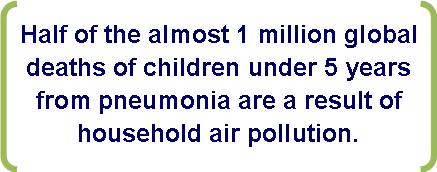Toward a world with cleaner air
Air pollution causes ~ 6.5 million deaths annually, according to the World Health Organisation (WHO). The main source of air pollution is fossil fuel and biomass combustion. An International Energy Agency report presents a Clean Air Scenario for reducing deaths from air pollution through tackling energy poverty, reducing pollutant emissions from combustion, and avoiding emissions by promoting clean forms of energy.
The main pollutants considered in the report are sulphur dioxide (SO2), nitrogen oxides (NOx), and fine particulate matter (PM2.5, with particle diameters below 2.5 µm). These pollutants mainly derive from the energy sector and are, for example, linked to lung cancer, low birth weight, reduced lung function and heart diseases. Children and the elderly are most vulnerable. In the developed world, most air-pollution-related premature deaths are caused by outdoor air pollution. However, globally, household air pollution is an even bigger problem. The WHO has concluded that half of the almost 1 million global deaths of children under 5 years from pneumonia are a result of household air pollution.
The report considers two scenarios. The New Policies Scenario takes into account current and planned measures to reduce air pollution. This scenario also includes the Intended Nationally Determined Contributions (INDCs) pledged by countries around the world as part of the Paris Agreement. These pledges, if implemented, will increase the proportion of clean energy sources such as wind and solar energy, thereby helping to avoid air pollution. By 2040, SO2, NOx and PM2.5 emissions will fall by 20%, 10% and 7%, respectively relative to 2015. Yet, deaths from outdoor air pollution will rise overall as urbanisation increases and as populations age, thus becoming more vulnerable to air pollution. Inefficient cook stoves also continue to be used widely, particularly in Sub-Saharan Africa.
The report considers two scenarios. The New Policies Scenario takes into account current and planned measures to reduce air pollution. This scenario also includes the Intended Nationally Determined Contributions (INDCs) pledged by countries around the world as part of the Paris Agreement. These pledges, if implemented, will increase the proportion of clean energy sources such as wind and solar energy, thereby helping to avoid air pollution. By 2040, SO2, NOx and PM2.5 emissions will fall by 20%, 10% and 7%, respectively relative to 2015. Yet, deaths from outdoor air pollution will rise overall as urbanisation increases and as populations age, thus becoming more vulnerable to air pollution. Inefficient cook stoves also continue to be used widely, particularly in Sub-Saharan Africa.
The Clean Air Scenario includes additional policies to improve air quality. It focuses on measures that can be implemented without requiring technological breakthroughs. Such measures include strict emission standards in the power sector and for vehicles that have been implemented successfully to reduce air pollution in the U.S., Europe and Japan. The scenario assumes a faster transition away from fossil fuels, as well as universal access to modern cooking fuels and electricity by 2040. Overall, this means that by 2040, emissions will fall over 50% for SO2 and NOx and by almost 75% for PM2.5.
Chapters on different countries or regions provide useful case studies for understanding the challenges and implications of the two scenarios. For example, 2.2 million of the current annual deaths from air pollution occur in China, where life expectancy is reduced by 25 months by poor air quality. The New Policies Scenario would increase life expectancy, but nevertheless, almost 2.5 million people are expected to die prematurely in China due to air pollution by 2040. Under the Clean Air Scenario, premature deaths in China are projected to stabilise at today’s level by 2040.
The report focuses on premature deaths from air pollution, but air pollution also affects people’s quality of life in ways not directly linked to survival. Several assessments have concluded that the benefits from air quality improvements far outweigh the costs. Why, then, is progress often slow? One problem is that the mitigation costs are immediate and concentrated, whereas the benefits occur over time periods of decades. Also, many of the benefits cannot easily be measured in economic terms. Nevertheless, there are signs that at least for SO2 and NOx, emerging and developing countries are on lower per-capita emissions pathways than those seen in Europe and North America in the past. If the ambitious air quality goals and strategies outlined in the report are accompanied by effective monitoring, evaluation, and enforcement the improvement in life expectancy and quality of life could be substantial.
Energy and air pollution. World Energy Outlook Special Report, OECD/IEA, 2016. Available to download free of charge from www.worldenergyoutlook.org/airpollution


